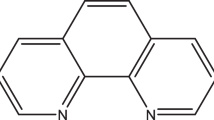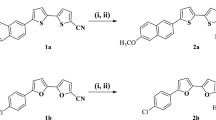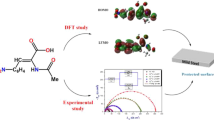Abstract
In view of the significant inhibiting effect of environmentally friendly compounds, Atovaquone [trans-2-[4-(4-chlorophenyl)cyclohexyl]-3-hydroxy1,4-naphthalenedione (CCHN)] and Proguanil hydrochloride [1-(4-chlorophenyl)-5-isopropylbiguanide hydrochloride (CIBH)] were employed in this work. The inhibitive efficacy of the two compounds was investigated by means of open circuit potential (OCP), electrochemical impedance spectroscopy (EIS) and potentiodynamic polarization (PDP), respectively. Both compounds were found to be very potent in slowing the rate of deterioration of mild steel in the studied environment. The inhibitors inhibited both the anodic and cathodic reactions in a mixed-type manner. CCHN, on the other hand, proved to be more effective than CIBH, with a maximum inhibition efficiency of 95.5% compared to CIBH's inhibition efficiency of 89.7%. The obtained result was validated using the Langmuir adsorption isotherm. The theoretical adsorption of the inhibitors on the iron slab cleaved at 110 angle [Fe (110)] surface was evaluated, and CCHN was found to have a higher adsorption strength, correlating with the experimental findings. Surface investigation techniques such as scanning electron microscopy (SEM), electron diffraction X-ray (EDX) and atomic force microscopy (AFM) were used to supplement the experimental and theoretical research. The results of the experiments show that the proposed techniques have the ability to appropriately depict performance indicators within the ranges of the components under consideration. The procedure outlined will aid in the development of a suitable strategy to future tests.

















Similar content being viewed by others
Data avaliability
The datasets generated during and/or analysed during the current study are available from the corresponding author on reasonable request.
Abbreviations
- AFM:
-
Atomic force microscopy
- AM1:
-
Austin Model 1
- BOP:
-
Becke One Parameter
- CCHN:
-
[Trans-2-[4-(4-chlorophenyl)cyclohexyl]-3-hydroxy1,4-naphthalenedione
- CIBH:
-
1-(4-Chlorophenyl)-5-isopropylbiguanide hydrochloride
- CPE:
-
Constant phase element
- DFT:
-
Density functional theory
- DNP:
-
Double numeric plus
- DSPP:
-
Semicore pseudopotentials
- EDX:
-
Energy disperse X-ray
- EIS:
-
Electrochemical impedance spectroscopy
- GGA:
-
Generalised Gradient Approximation
- HOMO:
-
Highest occupied molecular orbital
- K:
-
Kelvin
- LUMO:
-
Lowest unoccupied molecular orbital
- NDDO:
-
Neglect of Diatomic Differential Overlap
- NVE:
-
Constant-volume ensemble
- OCP:
-
Open circuit potential
- PAR:
-
Princeton applied research
- PDP:
-
Potentiodynamic polarization
- SCE:
-
Saturated calomel electrode
- SCF:
-
Self-consistent field
- SEM:
-
Scanning electron microscopy
- VAMP:
-
Voting Agent Model of Preferences
References
Pan YC, Wen Y, Xue LY, Guo XY, Yang HF (2012) Adsorption behavior of methimazole monolayers on a copper surface and its corrosion inhibition. J Phys Chem C 116:3532–3538
Sastri VS (2011) Green Corrosion Inhibitors: Theory and Practice. John Wiley & Sons Inc., Hoboken
Yadav DK, Quraishi MA (2012) Electrochemical investigation of Substituted Pyranopyrazoles Adsorption on Mild Steel in Acid Solution. Ind Eng Chem Res 51(24):8194–8210
Gopi D, Sherif EM, Manivannan V, Rajeswari D, Surendiran M, Kavitha L (2014) Corrosion and corrosion inhibition of mild steel in groundwater at different temperatures by newly synthesized benzotriazole and phosphono derivatives. Ind Eng Chem Res 53(11):4286–4294
Kumar S, Sharma D, Yadav P, Yadav M (2013) Experimental and quantum chemical studies on corrosion inhibition effect of synthesized organic compounds on N80 steel in hydrochloric acid. Ind Eng Chem Res 52(39):14019–14029
Murulana LC, Kabanda MM, Ebenso EE (2015) Experimental and theoretical studies on the corrosion inhibition of mild steel by some sulphonamides in aqueous HCl. Rsc Adv 5(36):28743–28761
Saha S, Dutta A, Ghosh P, Sukul D, Banerjee P (2015) Adsorption and corrosion inhibition effect of Schiff base molecules on the mild steel surface in 1 M HCl medium: a combined experimental and theoretical approach. Phys Chem Chem Phys 17(8):5679–5690
Oguzie EE, Li Y, Wang FH (2007a) Effect of 2-amino-3-mercaptopropanoic acid (cysteine) on the corrosion behaviour of low carbon steel in sulphuric acid. Electrochim Acta 53(2):909–914
Oguzie EE, Li Y, Wang FH (2007b) Effect of surface nanocrystallization on corrosion and corrosion inhibition of low carbon steel: Synergistic effect of methionine and iodide ion. Electrochim Acta 52(24):6988–6996
Karthik D, Tamilvendan D, Prabhu GV (2014) Study on the inhibition of mild steel corrosion by 1,3-bis-(morpholin-4-yl-phenyl-methyl)-thiourea in hydrochloric acid medium. J Saudi Chem Soc 18(6):835–844
Bereket G, Ogretir C, Yurt A (2001) Quantum mechanical calculations on some 4-methyl-5-substituted imidazole derivatives as acidic corrosion inhibitor for zinc. J Mol Struct (Theochem) 571:139–145
Khalil N (2003) Quantum chemical approach of corrosion inhibition. Electrochim Acta 48:2635–2640
Costa JM, Lluch JM (1984) The use of quantum mechanics calculations for the study of corrosion inhibitors. Corros Sci 24:924–933
Obi-Egbedi N, Essien K, Obot I, Ebenso E (2011a) 1, 2- Diaminoanthraquinone as corrosion inhibitor for mild steel in hydrochloricacid: weight loss and quantum chemical study. Int J Electrochem Sci 6:913–930
Obi-Egbedi N, Obot I, El-Khaiary MI (2011b) Quantum chemical investigation and statistical analysis of the relationship between corrosion inhibition efficiency and molecular structure of xanthene and its derivatives on mild steel in sulphuric acid. J Mol Struct 1002:86–96
Chidiebere MA, Oguzie EE, Li L, Ying L, Fuhui W (2014a) Ascorbic acid as corrosion inhibitor for Q235 mild steel in acidic environments. J Ind and Eng Chem 26:182–192
Chidiebere MA, Oguzie EE, Li L, Ying L, Fuhui W (2014b) Corrosion inhibition of Q235 mild steel in 0.5 M H2SO4 solution by phytic acid and synergistic iodide additives. Ind Eng Chem Res 53:7670–7679
Guo L, Obot IB, Zheng X, Shen X, Qiang Y, Kaya S (2017a) Theoretical insight into an empirical rule about organic corrosion inhibitors containing nitrogen, oxygen, and sulfur atoms. Appl Surf Sci 406:301–306
Guo L, Qi C, Zheng X, Zhang R, Shen X, Kaya S (2017b) Toward understanding the adsorption mechanism of large size organic corrosion inhibitors on an Fe (110) surface using the DFTB method. RSC Adv 7:29042–29050
Hammer B, Hansen B, Nørskov JK (1999) Improved adsorption energetics within density-functional theory using revised Perdew-Burke- Ernzerhof functionals. Phys Rev B 59:7413
Fouda AS, El-Desoky HS, Abdel-Galeil MA, Mansour D (2021) Niclosamide and dichlorphenamide: new and effective corrosion inhibitors for carbon steel in 1M HCl solution. SN Appl Sci 3:287
Hameed RSA, Aljohani MM, Essa AB, Khaled A (2021) Electrochemical techniques for evaluation of expired megavit drugs as corrosion inhibitor for steel in hydrochloric acid. Int J Electrochem Sci 16
Singh A, Gupta A, Rawat AK, Ansari K, Quraishi M, Ebenso EE (2014) Cimetidine as an effective corrosion inhibitor for mild steel in hydrochloric acid. Int J Electrochem Sci 9:7614–7628
Singh AK, Quraishi MA (2011) Adsorption properties and inhibition of mild steel corrosion in hydrochloric acid solution by ceftobiprole. J Appl Electrochem 41(1):7–18
Jarvis SP, Taylor S, Baran JD, Thompson D, Saywell A, Mangham B (2015) Physisorption controls the conformation and density of states of an adsorbed porphyrin. J Phys Chem C 119:27982–27994
Yesudass S, Olasunkanmi LO, Bahadur I, Kabanda MM, Obot I, Ebenso EE (2016) Experimental and theoretical studies on some selected ionic liquids with different cations/anions as corrosion inhibitors for mild steel in acidic medium. J Taiwan Inst Chem Eng 64:252–268
Yurt A, Ulutas S, Dal H (2006) Electrochemical and theoretical investigation on the corrosion of aluminiumin acidic solution containing some Schiff bases. Appl Surf Sci 253:919–925
Khaled K, Abdelshafi N, El-Maghraby A, Aouniti A, Al-Mobarak N, Hammouti B (2012) Alanine as corrosion inhibitor for iron in acid medium: a molecular level study. Int J Electrochem Sci 7:12706–12719
Schmitti G, Bedbur K (1985) Investigation on structural and electronic effects in acid inhibitors by AC impedance. Werks Korros 36:273–280
Quraishi MA, Jamal D (2000) Technical note: CAHMT—a new and eco-friendly acidizing corrosion inhibitor. Corrosion 56:983–985
Finšgar M, Fassbender S, Hirth S, Milošev I (2009a) Electrochemical and XPS study of polyethyleneimines of different molecular sizes as corrosion inhibitors for AISI 430 stainless steel in near-neutral chloride media. Mater Chem Phys 116:198–206
Finšgar M, Fassbender S, Nicolini F, Milošev I (2009b) Polyethyleneimine as a corrosion inhibitor for ASTM 420 stainless steel in near-neutral saline media. Corros Sci 51:525–533
Okafor PC, Oguzie EE, Iniama GE (2008) Corrosion inhibition properties of thiosemicarbazone and semicarbazone derivatives in concentrated acid environment. Glob J Pure Appl Sci 14:89–95
Oguzie EE, Adindu CB, Enenebeaku CK (2012) Natural products for materials protection: mechanism of corrosion inhibition of mild steel by acid extracts of Piper guineense. J Phys Chem C 116(25):13603–13615
Yadav M, Kumar S, Gope L (2014) Experimental and theoretical study on amino acid derivatives as eco-friendly corrosion inhibitor on mild steel in hydrochloric acid solution. J Adhes Sci Tech 28(11):1072–1089
Chidiebere MA, Ogukwe CE, Oguzie KL, Eneh CN, Oguzie EE (2012) Corrosion inhibition and adsorption behavior of Punica granatum extract on carbon steel in acidic environments: experimental and theoretical studies. Ind Eng Chem Res 51:668–677
Dubey AK, Singh G (2007) Corrosion inhibition of carbon steel in sulphuric acid solution by using polyethylene glycol methyl ether (PEGME). Port Electrochim Acta 25:221–235
Ebenso EE, Oguzie EE (2005) Corrosion inhibition of carbon steel in acidic media by some organic dyes. Mater Lett 59:2163–2165
Nwanonenyi SC, Obasi HC, Chidiebere AM (2018) Inhibitive performance of carboxymethyl cellulose and additives on corrosion of carbon steel in acidic and alkaline environments. J Bio Tribo Corrosion 4
Simeon CN, Ezeani EO, Chizoba MO, Chidiebere AM, Emeka EO (2021) Protection of carbon steel surface in extreme environment using polymer mixture: effects of time, inhibitor concentration, mixing ratio and synergy. Saf Extreme Environ 2(3):245–258
Obot IB, Obi-Egbedi NO (2010) Adsorption properties and inhibition of carbon steel corrosion in sulphuric acid solution by ketoconazole: experimental and theoretical investigation. Corros Sci 52:198–204
Umoren SA, Ebenso EE, Okafor PC, Ogbobe O (2006) Water soluble polymers as corrosion inhibitors of carbon steel in acidic medium. Pigment Resin Technol 35(6):346–352
Shams A, Yahui Z, Faisal K (2018) electrochemical behavior and analysis of Zn and Zn – Ni alloy anti-corrosive coatings deposited from citrate baths. RSC Adv. 8:28861–28873
Gomez B, Likhanova NV, Dominguez-Aguilar MA, Martinez-Palou R, Vela A, Gazquez JL (2006) Quantum chemical study of the inhibitive properties of 2-pyridyl-azoles. J Phys Chem B 110:8928–8934
Dewar MJS, Zoebisch EG, Healy EF, Stewart JJP (1985) Development and use of quantum mechanical molecular models. 76. AM1: a new general purpose quantum mechanical molecular model. J Am Chem Soc 107:3902–3909
Awad MK, Mustafa MR, Elnga MMA (2010) Computational simulation of the molecular structure of some triazoles as inhibitors for the corrosion of metal surface. THEOCHEM 959:66–74
Casewit CJ, Colwell KS, Rappe AK (1992) Application of universal force field to main group elements. J Am Chem Soc 114:10046–10053
Nwanonenyi SC, Arukalam IO, Obasi HC, Ezeamaku UL, Eze IO, Chukwujike IC, Chidiebere MA (2017) Corrosion inhibitive behavior and adsorption of millet (Panicum miliaceum) starch on carbon steel in hydrochloric acid environment. J Bio Tribo Corros 3:54
Oguzie EE, Enenebeaku CK, Akalezi CO, Okoro SC, Ayuk AA, Ejike EN (2010) Adsorption and corrosion-inhibiting effect of Dacryodis edulis extract on low-carbon-steel corrosion in acidic media. J Colloid Interface Sci 349:283–292
Obot IB, Obi-Egbedi NO, Eseola AO (2011) Anticorrosion potential of 2-mesityl-1H-imidazo[4,5-f][1,10]-phenanthroline on mild steel in sulfuric acid solution: Experimental and theoretical study. Ind Eng Chem Res 50:2098–2110
Acknowledgements
Support from the World Bank Africa Centres of Excellence for Impact (ACE Impact) Project (NUC/ES/507/1/304) is gratefully acknowledged.
Author information
Authors and Affiliations
Corresponding author
Ethics declarations
Conflict of interest
The authors declare that they have no conflict of interest.
Rights and permissions
Springer Nature or its licensor holds exclusive rights to this article under a publishing agreement with the author(s) or other rightsholder(s); author self-archiving of the accepted manuscript version of this article is solely governed by the terms of such publishing agreement and applicable law.
About this article
Cite this article
Chidiebere, A.M., Christopher, A., Bilar, A. et al. The effect of molecular structure on the control of mild steel dissolution in acidic environment: theoretical, experimental and surface probe approach. Saf. Extreme Environ. 4, 211–229 (2022). https://doi.org/10.1007/s42797-022-00062-4
Received:
Revised:
Accepted:
Published:
Issue Date:
DOI: https://doi.org/10.1007/s42797-022-00062-4




